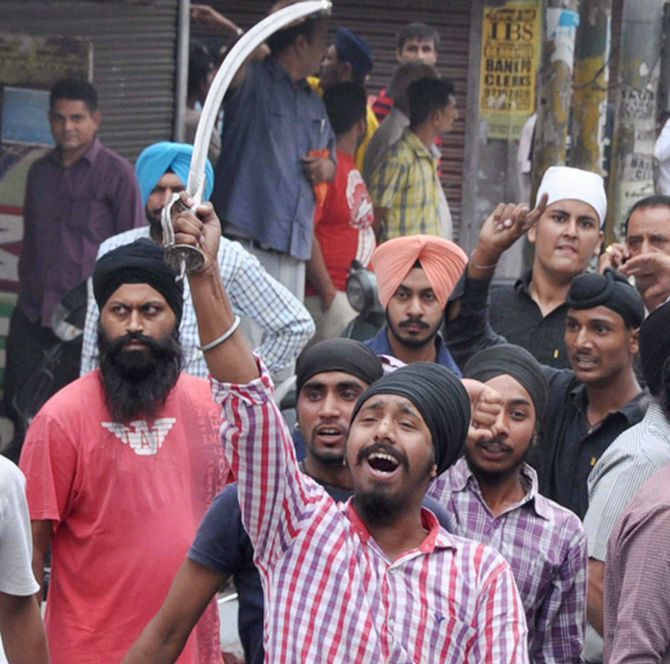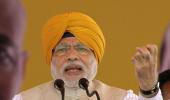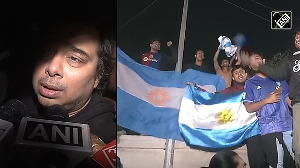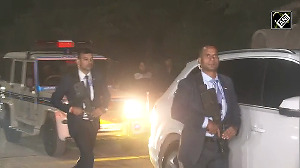 It is as much about farmer woes and the lack of job opportunities as about the mixing of religion and politics, reports Akshat Kaushal.
It is as much about farmer woes and the lack of job opportunities as about the mixing of religion and politics, reports Akshat Kaushal.
A few metres from where he was shot dead, near the Golden Temple in Amritsar, Jarnail Singh Bhindranwale continues to live on T-shirts and posters. There are shops that sell printed copies of his speeches.
It doesn't strike anyone here that in official records Bhindranwale was a terrorist. Instead, to these people, as to many others in Punjab, Bhindranwale is a saint who was undone by the political machinations of New Delhi.
His posters can be seen in panchayat offices and on streets across Punjab. Outside Bhabal, the village in Faridkot where two men were killed and four injured after the police fired upon a restive crowd, the poster condemning the action has a Bhindranwale picture.
Even Sardar Sucha Singh Chhotepur, the Aam Aadmi Party leader and Parliamentarian, chooses to call him a saint.
This re-emergence of Bhindranwale has been noticed with concern by many. The question being asked is: Will Punjab slip back into militancy?
There have been unconfirmed news reports that the Intelligence Bureau had warned the Punjab government of Pakistan's Inter-Service Intelligence trying to revive the Sikh separatist movement. The Gurdaspur terrorist attack was cited as an instance.
Punjab's former top cop, K P S Gill, also alluded to terrorism getting a new life if the state was not on alert.
On the ground, there is little evidence to suggest that Punjab might return to the violent days of the 1980s. The opinion among the masses -- in towns as well as villages -- is that it will not happen. Most people say the separatists caused serious losses to them, personal and material, and, therefore, there is little merit in rekindling the Khalistan demand.
"Punjab has been on the boil for the last several years and there are various reasons for it. But the revival of the demand for Khalistan is out of the question. The people of Punjab are not in favour of it," says Shashi Kant, a former top cop of Punjab.
Serving police and administrative officials make similar observations. These officers say the role of the ISI seems to have been exaggerated by the intelligence agencies.
What is palpable is the public discontent -- more so in the villages. The Whitefly pest has destroyed the cotton crop. Pesticides they used proved ineffective. Farmers are convinced it was adulterated and are upset the state government has provided them no help. In the entire cotton belt of Punjab, anger is running high.
Even otherwise, farmers in the state are an unhappy lot. Ajay Vir Jakhar, the chairman of Bharat Krishak Samaj, in a recent column in The Indian Express, cited several reasons for it. One, there are too may tractors in the state. A tractor becomes viable when used for 900 hours in a year. The average usage in Punjab is probably half of that, leading owners to lifelong indebtedness.
Two, free electricity has led to over-irrigation and the water table has plummeted, which has raised the cost of drawing water.
And three, political interference in cooperative banks and societies has caused heavy-duty window dressing, which resulted in Punjab getting just 2 per cent of the funds in the infamous farm loan waiver by the United Progressive Alliance government.
What has made matters worse is the near absence of non-farm jobs in the state. A lot of industry moved from Punjab to Himachal Pradesh after the Centre announced tax incentives for units located in the northern hill states of Jammu & Kashmir, Himachal Pradesh and Uttarakhand.
The state government's hope to transform the industrial landscape hinged on trade with Pakistan opening up: Factories would set up in Punjab and ship their produce quickly to Pakistan. However, Pakistan's refusal to give India the 'most favoured nation' status has put paid to all such plans.
All this has made people bitter, and their ire is focused on the state government.
In the cotton-growing regions, the resentment has reached such proportions that district officials are scared to venture alone into the villages. An agriculture officer who accompanies me to one of the villages is warned to return as men in the village are angry and might attack him. The officer makes a retreat.
"We are not afraid of the police. If they have arms, we have arms too," says Nirmal Singh, 53, of Bhabal village, where the police had fired on the crowd.
 The current wave of unrest in Punjab began in June when a copy of the Guru Granth Sahib was stolen from a gurdwara in the Jawahar Singh village in Faridkot. Villagers allege that the police dragged its feet on the case and did little to recover the stolen book.
The current wave of unrest in Punjab began in June when a copy of the Guru Granth Sahib was stolen from a gurdwara in the Jawahar Singh village in Faridkot. Villagers allege that the police dragged its feet on the case and did little to recover the stolen book.
Later, on October 12, pages of another Guru Granth Sahib were found in the lanes of Bargeri village in Faridkot. People found these pages as they were exiting the gurdwara. Protests erupted and the police had to open fire to disperse the crowds.
Resentment against the ruling Shiromani Akali Dal government is rampant. Apart from the recent failure of the state government in handling a peaceful protest, the Parkash Singh Badal government has drawn the ire of the people for its failure to rein in the widespread prevalence of drugs, less than expected industrial growth and general apathy towards citizen issues.
Until now, the Badal government had addressed the recent unrest as a law and order issue. People in the know insist that the present unrest is essentially a result of a power struggle over Sikh votes -- the elections to the state legislative assembly are due in 2017.
The fight over the Sikh votes has its genesis in 2007 and relates to Gurmeet Ram Rahim Singh, the chief of the Sirsa-based Dera Sacha Sauda. In that year, the leader, who has acted in films and cut music videos, faced the anger of the Sikh clergy for dressing up as Guru Gobind Singh, the tenth Sikh Guru.
Earlier this year, the Akal Takht -- which is the final arbiter on all religious matters -- granted a pardon to the Dera Sacha Sauda chief. This irked a large number of Sikhs and divided the Sikh clergy too, a section of which continues to oppose the decision of the Akal Takht.
According to some members of the Shiromani Gurudwara Prabandhak Committee, or SGPC, this pardon has been given at the instance of the Akali leadership to attract Dera followers ahead of the 2017 elections.
But the fight over Sikh votes is not limited to the Dera chief. The struggle is also over who controls the two most significant Sikh institutions: The SGPC and the Akal Takht.
Traditionally, the SGPC is seen as a counterpoise to the Shiromani Akali Dal, which is led by Badal. However, in recent times, the SGPC is seen as having lost its autonomy to the Shiromani Akali Dal.
"The SGPC is now made to follow orders from the chief minister's office. This was never the case before. This situation has arisen because the present SGPC president (Avtar Singh Makkar) is seen as a relative lightweight compared to the chief minister (Badal)," says a senior member of the SGPC.
Politics is difficult to segregate from religion in Punjab. Jakhar, in his column, wrote that the state has paid the price of following a religious-political agenda. In contrast, Haryana, which was considered the backwater of undivided Punjab, followed a strictly economic agenda. The difference is there for all to see: Haryana is far ahead of Punjab in terms of per capita income.











